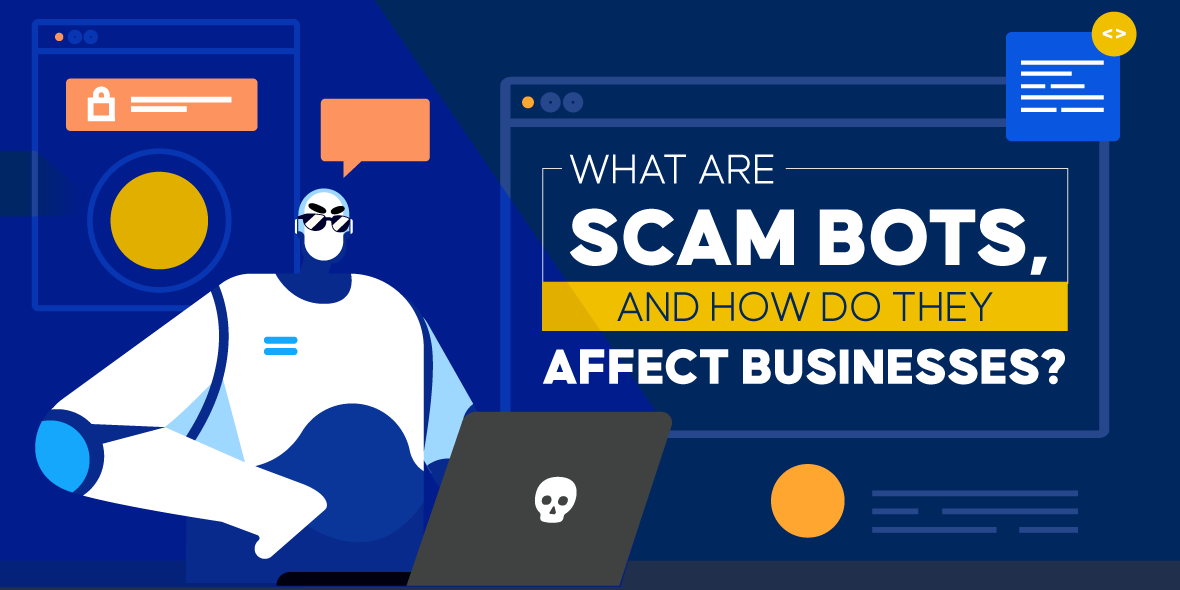Have you ever noticed spam comments on social media platforms goods or offers that seem too good to be true? Perhaps you saw comments that seemed to be out of context and inappropriate.
Well, scam bots are responsible for these types of actions. Automated posts, comments, and messages regularly flood social networking sites such as Instagram, YouTube, Facebook, and Twitter.
Scam bots can like, write, share, and post like how people act online, but they usually publish content that advertises freebies, discounts, offers, or adult content. There has been a rise in this type of activity, and it is significantly affecting businesses.
Over 40% of internet traffic is attributed to bots.
– Data Dome
Although bot traffic may appear beneficial to your business’s brand exposure, bot traffic does more harm than good. It slows down page load speed, affecting customer experience while browsing your website, which is never a good thing because poor performance or lousy load time can decrease customer loyalty.
Scam bots are also a threat to digital security because they can steal customer information, which can hinder your company’s reputation. Thankfully, this blog covers everything you need to know about scam bots, so you can understand how they might be affecting your business.
What are Scam Bots?
Scam bots are sometimes referred to as spam bots due to their ability to relay multiple comments and messages simultaneously. They essentially set up fake accounts on social media sites and other platforms where they disguise their actions as legitimate users.
There is a multitude of different bots; some are used to boost a company’s online presence, while others are operated for harmful purposes. Scam bots, in particular, are malicious bots intended to perform bot fraud attempts. They carry out repetitive tasks online, such as sending spam messages and engaging with users online through social media sites.
Aside from pretending to be real people online, scam bots perform automated phishing, bot-driven account takeover attacks, and other automated fraud attempts. Artificial intelligence (AI) and machine learning help scam bots speedily perform cyberattacks, and cybercriminals are taking advantage of this, getting the upper hand for monetization schemes.

How Do Scam Bots Operate?
Scam bots function in various ways, depending on the platform. For instance, scam bots can create accounts on social media platforms such as Instagram and YouTube where they can interact as real people in social groups, communities, and forums. AI and machine learning help disguise scam bots, mimicking human-like conversations and fooling other platform users.
Technologies aid scam bots in performing multiple signups and swamping social media sites with spam accounts. Once registered, they can access the platform freely and start spam comments, posts, and messages. Their content typically entices users, from offering ways how to get rich to getting involved in the adult industry.
Scam bots work rapidly even with numerous tasks, and it only takes one successful attempt for scam bots to achieve bot fraud. A simple scam bot can cause severe damage to a person or business. For example, a scam bot can send out lots of emails containing fraudulent links, and it only takes one individual to be victimized for the attack to be profitable.
Meanwhile, some scam bots are configured to gather information from the Internet to sell it on the dark web, a secret network of websites only accessed with a specialized web browser. These data include contact numbers, email addresses, social accounts, and other personal details.
What Industries Can Scam Bots Threaten?
Advertising
Trust plays a significant role in the advertising world. However, scam bots counter this by promoting suspicion and doubt between seller and advertiser. Online advertising platforms usually run a pay-per-click click (PPC) system, meaning the advertiser only pays when their advertisement is clicked on. Sellers sometimes use bots to produce fraudulent clicks to make more money.
The advertiser is cheated when bots begin clicking on the advertisement. While advertising costs are increasing, there is no return because the clicks are not genuine. As a result, businesses need help finding trusted advertising platforms.
Finance
Cybercriminals intentionally target the finance industry because more money is involved, indicating a more profitable return. Scam bots are used to execute account takeover (ATO) and distributed denial of service (DDoS) attacks. ATO occurs when bots perform credential stuffing or steal usernames and passwords to access personal accounts.
On the other hand, DDoS invades a company’s website by increasing traffic to the point where servers become overloaded, and the site has to shut down. Application DDoS is complicated to identify and halt because it uses bots to send targeted application requests that seem legitimate, including search queries and other computationally intensive processes.
Cybercriminals typically demand money to let the company’s site resume normal operations, but some take advantage while security defenses are down, executing more attacks. When such attacks happen, it’s no surprise that clients begin to mistrust banks, financial institutions, and insurance companies.
Hospitality
Scam bots take a toll on the travel and hospitality industry. They can send fake inquiries about bookings, which website owners spend time and effort answering. Since they are not legitimate queries, the company’s energy is only wasted.
Competitor sites can also collect data from the scam bots’ fake inquiries to know about the rates of other travel websites. Through this, they can undercut their rivals by offering more competitive rates. Another way scam bots affect this industry is by ripping off an account’s loyalty points and gift cards. Hence, customers begin to distrust travel agencies.
Marketing
In the same way, scam bots steal information from web pages to publish or sell to other websites. Sometimes, websites that steal ideas from a rival generate more traffic, gain more customers, and make more money than the original content creator.
The marketplace can also suffer a bad reputation if flooded with fake inquiries from scam bots. Fake leads waste efforts, and users might prefer to have their listings posted elsewhere. Marketplace owners are then left with negative reviews and fewer customers.
eCommerce
Scam bots hurt the eCommerce industry by performing attacks such as inventory hoarding, web scraping, fake account creation, and fake site creation. A typical harmful example is when scam bots add items to their shopping carts and leave them to stay. Since putting things in the cart reduces stocks, it gives the impression that items are sold out or low in supply.
Real customers won’t be able to purchase what they want, leading them to visit a different store. As a result, an eCommerce business loses sales and customers.
Entertainment
The media or entertainment industry is another victim of scam bots. Thousands or millions of followers sound great, but many influencers and celebrities suffer spam comments from fake accounts. They also need help tracking progress and performance since many interactions are from scam bots.
Since scam bots generate fake accounts, they can also be used to spread misinformation and perform account fraud, including account takeover, cracking, and carding.
How Much Damage Have Scam Bots Done?
Scam bots have done a significant amount of damage to multiple individuals and businesses belonging to different industries. Although foot traffic is excellent for online commerce, especially those aiming to increase conversion rates, about 40% of internet traffic is attributed to bots, resulting in a lot of wasted time and effort.
Finance and ticketing are two industries greatly affected by scam bots, with 42% targeting the finance and banking sectors. Many companies have suffered significant losses due to monetization tactics and phishing schemes by scam bots.
In 2015, TaoBao (a platform owned by Alibaba) became a victim of a bot-fraud attack that led to the compromise of more than 20 million active users. Scam bots target both large and small enterprises, and it only takes a simple single bot-driven attack to cause a deadly chain reaction.
What Are the Effects of Scam Bots on Businesses
1. Scam bots can affect a business’s reputation
When bots stump customers who interact online, brand retention and trust can be affected. Scam bots can send customers spam messages containing malicious links and provocative content, create fake product reviews, and steal user credentials. These actions and more destroy a company’s reputation and push customers away.
2. Scam bots can negatively affect SEO
The website’s domain authority can be affected if bots web scrapes copyright and content. Websites sometimes use scam bots to reproduce copyrighted or trademarked data from rival web pages. The website’s search authority weakens since multiple versions of the same content exist online, which can lead to wrongful penalizations.
3. Scam bots can skew analytics
Scam bots generate non-existent leads, such as abandoned online shopping carts and fake accounts that follow content creators. These fake leads clutter the metrics that track progress, making them inaccurate and causing business decisions to be inadequate.
Meanwhile, other attacks like DDoS strikes impact web traffic metrics by causing an application or network to shut down.
4. Scam bots can decrease revenue
Scam bots are extremely harmful because their damages can produce a domino effect. Pursuing fake leads, losing customers, and unresponsive websites and applications all act to impede revenue.
5. Scam bots can mess with advertising ROI
Scam bots take up more resources by consuming pay-per-click advertising. While companies invest in promoting products or services, scam bots generate fraudulent clicks. Since they are non-human clicks, there is no income or return.
6. Scam bots can slow down website speed
Customers prefer websites that run smoothly and are easy to use. Scam bots can flood a web page with traffic to cause poor performance. Unfortunately, the web analytics reports’ filters can’t stop these bots’ activities. As a result, it gives a bad impression to new visitors and might even drive away existing customers.
7. Scam bots can impact cybersecurity
A botnet is a combination of robots and networks. Malicious hackers produce botnets to perform cybercrimes. They establish a botnet by locating previously infected devices. The more connected bots that are present, the stronger the effect. For example, DDoS attacks impair a website, putting its security at risk, so scam bots can access login credentials and sensitive data.
How to stop scam bots?
There are various ways to prevent or stop scam bots from invading your business. The following are helpful practices to avoid harm brought by scam bots.
reCAPTCHA
It is the best and easiest way to prevent spam and manage abusive online traffic. reCAPTCHA utilizes an advanced risk analysis engine and adaptive challenges to counteract harmful automated software.
From knowing how to stop spam bots on Instagram to screening them on other platforms, reCAPTCHA’s validation test lets real users pass while bots fail. The best part about this effective tool is that it does not cost a thing.
Opt-In
Confirmed or double opt-in sends an email verifying if the email account belongs to you. The email contains a link saying you have successfully signed up to activate your account. If you choose to subscribe to any newsletter, an email will be sent to you, and you must click the link indicating that you have chosen to receive newsletters.
Opt-in is a security feature that stops spam bots from sending unnecessary messages. It also prevents misspelled or invalid emails and leads marketers to genuine leads instead of fake customers.
Detection
There are some obvious signs of whether an account is a bot. The message usually contains arrows insistently pointing to links that are phishing sites, and the news comes from unexpected sources, such as people you do not know. Messages are also usually irrelevant and have grammatical errors.
Honeypot fields
The honeypot captcha technique captures scam bots by putting a hidden text field or checkbox in sign-up forms. Real users cannot see them, while scam bots can make catching them more accessible. Once exposed, they can be blocked from the website.
Third-party app
You can install various plugins or programs to your website to restrict spam signups without performing manual labor. Doing so lets you focus on more critical business operations like increasing sales and improving customer satisfaction.
Block off scam bots for better business
Scam bots have integrated themselves into different platforms for malicious reasons. Although this trend is growing, it is something every industry should pay attention to. Businesses should no longer suffer more losses than they should, as there are safety measures that can be put in place to avoid them.
Cybersecurity training is crucial because it minimizes the dangers of cyberattacks and data breaches. This should be prioritized as breaches cause downtime and consume funds to recover from, which are both detrimental to any business.
Scam bots and cyber-related damages impact other aspects of a company, including its reputation, sales, customers, and revenue. Check out The Importance of Cybersecurity for E-Commerce to learn more about why you should prioritize cybersecurity to keep your business safe from harmful attacks.







